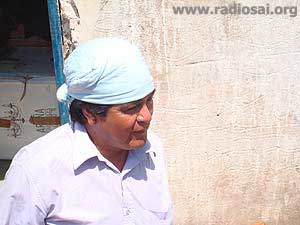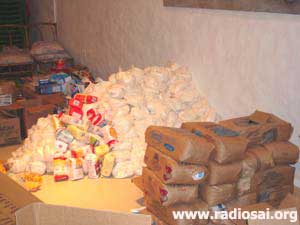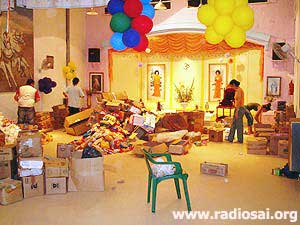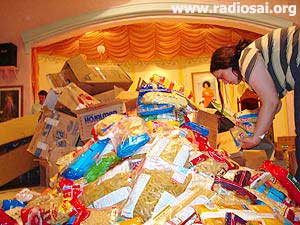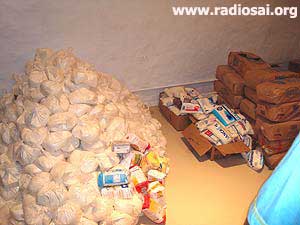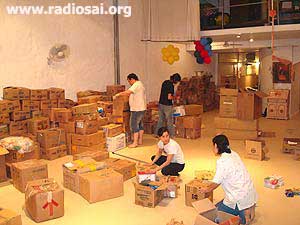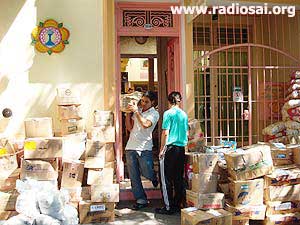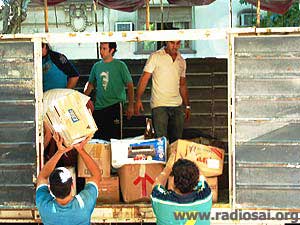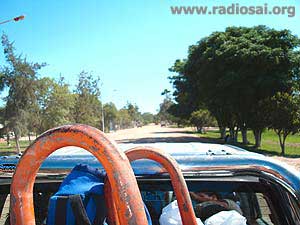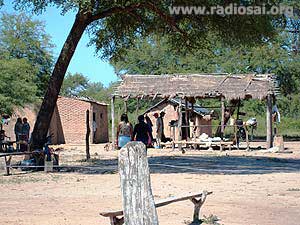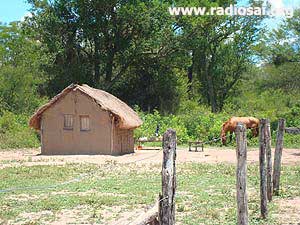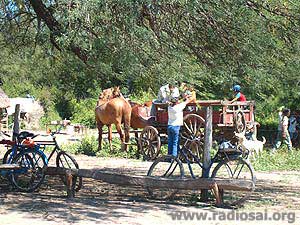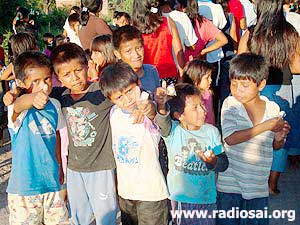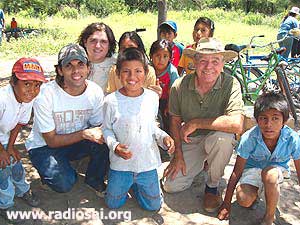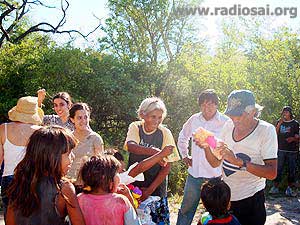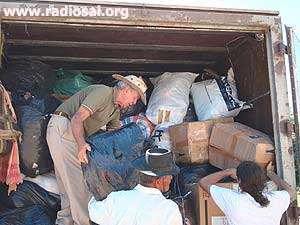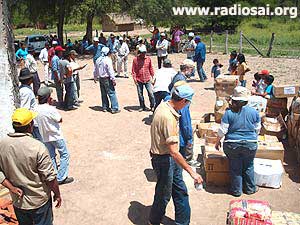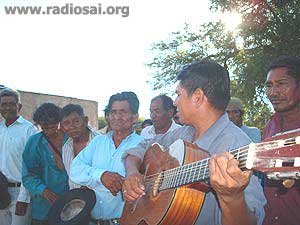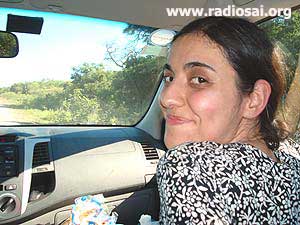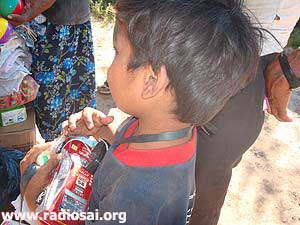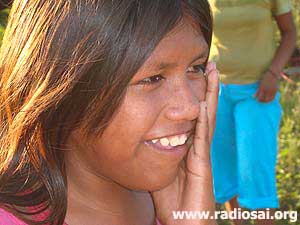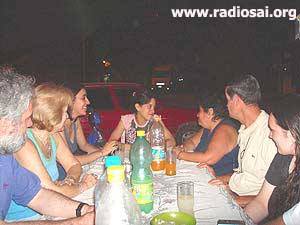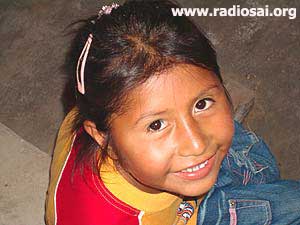 |
 |
 |
Volume
6 - Issue 02
FEBRUARY - 2008 |
Touched by a Troubled People
After the first Sai Youth Conference in Argentina held in Buenos Aires, the inspired young brigade were keen to practice what they had learnt and were looking for opportunities to be of help. It was at this time that a prominent Argentinean magazine, Clarin, published an article on the severe hardships being undergone by the native Toba population (also known as the Qom). Hunger, water shortages, poor healthcare and pathetic housing had robbed them of their self respect and dignity, and now were threatening their very existence. These people lived in the Chaco area of Argentina – 150,000 square kilometres of poor agricultural land which was home to mostly native peoples who had inhabited those parts much before the arrival of the Spanish. The Youth intuitively felt that it is this community to whom they would reach out and share His love. More than offer them material help, they were keen first to understand their way of life and living conditions. There were a lot of questions to be answered. They were unsure how the project would pan out and had no idea in which area of the vast Chaco woods they would go. But the Youth, in their heart of hearts, felt that all would fall into place with time, guided by the unseen but all powerful Hand of the Lord. The Project Sees the Light As a first step, they began to meet once a week to discuss how the project could take shape. What kind of service should they render? What were the priorities of the Qom people? Who should be involved in this project? They did appropriate research and in subsequent weeks answered every question that came up. Though at times they reached an impasse and some sessions made little progress, nothing dispirited them as they were confident Sai was watching them all through. While small decisions were taken in the planning of the project, another valuable off shoot of these frequent interactions was the understanding and unity that blossomed among the youth. They learnt to listen, appreciate and be tolerant of diverse opinions. After this happened, came the crucial turning point in their service project. By Divine design, they met Clemente, a Qom Chief, who had left his native Chaco following the harvest roads with other families many years ago, and had been a resident of Buenos Aires for the past 13 years. He had first settled in Santa Fé, but later moved with his family to Fuerte Apache, a dangerous shantytown of Buenos Aires. Here his family suffered not only discrimination and poverty (that they were more or less used to), but also became victims of violence due to the delinquent behaviour rampant in that area.
The good hearted Clemente, whose heart was always with his people, sent small truckloads of necessary goods into the woods whenever he could. And when the Sai youth enquired with him about the needs of Qom people, he readily shared all his experiences. He told them how water was scarce and each community was affected by isolation from each other, and also how, unfortunately, they were all deprived of any of the benefits of ‘civilisation’. But the important aspect that Clemente emphasised from his experience was that the project should have a personal touch and should serve to build bridges of communication and friendship, as the Qom not only required physical things but also human touch, love and kindness. That struck a note with the Sai group. In fact, they felt moved to place their love for these people at the forefront of their service. It was perfectly in line with what Swami had said: Service should be performed to the common Indweller in all. When they saw the Qom people, they wanted to remind themselves: “Swami, You are the Indweller and You manifest Yourself in everyone”. Learning About a Noble Community With Clemente coming in, the project started taking concrete shape. The youth learnt that food and clothes were important requirements for the Qom. One night, the humble Clemente described to the youth a world very different from what is taught in school about the native peoples. He gave the group another vision of the ‘Day of the Race’ celebrations of 12 October (the day commemorating the famed expedition of Columbus to the West but opposed by many because an estimated 85 percent of the Native American population was wiped out within 150 years of Columbus’ arrival in America). He explained to them why the Qom elders celebrated 11 October as their last day of freedom! “Unity, the lamp of Love that Swami shines in our hearts, was bright that night, and several brothers felt touched by the privations of the Qom people,” remarked a Sai youth. After this moving experience, the group’s enthusiasm soared, and they gathered the needed information, organised logistics, networked and encouraged each other in the noble service project. The love for their Qom brothers in need started to flow effortlessly and irrepressibly, and soon became an all pervading tide! Sai, in His inimitable way, had moved all their hearts, and the Divine drama was slowly and beautifully being unfolded. The Thousand Faces of Love
The moment the project was finalised, donations started pouring in at the Sai Centre of Uriarte, which was the centre of operations. “We felt that truly ‘Love is everywhere’,” a Sai Youth recalls. First, the clothes arrived. Though supplies were coming in, the group were still worried if they would have enough supplies for the Qom people. And then, they needed a lorry full of food. To go with less would be a let down for the group and for the Qom people. But where was it going to come from? It was at this time they received a message that in the nearby suburbs of Buenos Aires of Pilar and Derqui, there were hundreds of kilograms of donated food awaiting collection from the Sai Organisation and their friends! They were overwhelmed by His Grace. In fact, there was not enough room for the enormous quantities of ‘Love-food’ that continued to arrive. The Sai Centre was being refurbished as Swami’s Birthday was approaching, so, they had to find room in people’s homes - in every corner, on the floor, and sometimes up to the roof! This solidarity grew to mountainous sizes and the group could only watch in amazement as it all arrived - almost mysteriously. To watch the manifestation of love of thousands of brothers, united under one objective, was an overpowering experience. They were stunned in gratitude to the One who was ensuring that the Qom would receive adequately from His abundance.
Overflowing Donations and Overwhelmed Hearts The next step was organising the donations and many willing hands joined in. "We should offer to others only what we would offer to our own family." Swami’s words were ringing in their ears and they started selecting clothes that were in good condition and divided them to suit men, women, children, infants, and by season. Shoes were grouped in pairs, discarding all that were in bad condition. Even though they sorted several bags per hour, they always had more waiting as donations never stopped. Arranging the food donations was a massive but joyful task. Clemente had remarked that most of the families numbered about ten in each, so accordingly they tried to calculate the right quantities of flour, balanced with appropriate measures of grain, protein and legumes. They apportioned all the food weighing it with care. Bags of rice, polenta, mate herb, flour, salt, and sugar were opened and sorted with enthusiasm! Finally they were transported to the Sai Centre and put in boxes, which itself was an elaborate affair.
There were boxes of several sizes that had to be filled equally. The boxes tagged “C” were large ones, while “A” and “B” were the smaller ones. These two together made a “C” which had all the items for a family and were to be given two per house. Mountains of polenta, rice, sugar and lentils ‘grew’ on the floor of the Sai Centre to be placed into these boxes. The Sai Centre transformed into a packaging centre and every evening after work the select group of volunteers responsible for packing gathered and worked till dawn! (Many of them had day jobs.) They were exhausted but so fired with enthusiasm too! They wanted to give their very best. On one of the last nights there was still much to get done and they counted the “B” boxes to find only 50. It was 11.30 p.m. and there was another 100 to finish, plus another 100 of “A” boxes. Overwhelmed with the enormity of uncompleted work, they prayed, “Swami, please do it Yourself. It is impossible for us to do in a few hours what we could not accomplish in several days!” And the Lord did help. In four hours they had completed the “A” boxes, which though heavily laden, were fast growing in number. The line of “B” boxes registered 100 and the “A” ones were surpassing the 70 mark!
In a couple of hours purely by His Grace they had completed the mammoth task of assembling more than 200 boxes! It meant the promise of supplying 70 families of “Nueva Población” and another 70 living in what Clemente called the “impenetrable outback” – little hamlets lost in the woods of Chaco who rarely see outsiders let alone receive aid – could find fulfilment. The Test and the Triumph On the penultimate day when they had finished labelling the boxes and everyone was relaxed and happy, they received a shock. The lorry firm that was to take all the items to Castelli, the big town which was to be a stop-off point on the way, cancelled the trip! In rather a panic, they started searching for an alternative to leave the next day, else all their plans would go awry. With His Grace they found a transport company, but this one would only go to Resistencia, the capital of Chaco. From there their destination was another 300 kilometres to Castelli and from there a further 60 km through the woods. Hectic telephoning worked out the necessary connections and logistical adjustments.
Finally the alternate lorry arrived two hours late at Uriarte Sai Centre, on a Thursday morning. A group of Sai brothers made a line and loaded everything into the lorry at the end of which the truck looked overfilled. The Youth were happy they faced up to the challenge and reacted spontaneously to the best of their ability. They did not complain but loved the Lord’s uncertainty. And thanks to Him, the work was completed smoothly. Hands and Faces of His Love There were many inspired people who wanted to take the long journey to meet and distribute the items to the Qom. But given the lack of information about exact conditions of the destination in the Chaco outback, the organizing group evaluated who might make the arduous journey with utmost care. And they decided on ten volunteers who would make the journey. They were many who had helped at various stages of the operation and were keen to make the trip, but they accepted the decision recognising that all are His instruments, none more important than the other, and each one was playing his or her role in His work depending on their suitability and His Will. In fact, assistance for the project came not only from Buenos Aires but also from the centres of Rosario, La Rioja, La Plata, and Cordoba. A devotee from the city of Lincoln, put his pick-up truck at the disposal of the group, and it was gratefully used for transportation of some group members all the way into the Chaco woods and back! The rest of the group, Clemente included, travelled by bus to Castelli.
Departure to Chaco The first group departed from Retiro Station on a Thursday afternoon; the second on Friday morning from Uriarte Sai Centre for Resistencia town (1,300 km), where they would offload the donations from the truck that brought them and load them to a new one that was bound for Castelli. During the journey the devotee from Lincoln related an amazing incident. When he had decided to join and help the project, Swami had given him a most enigmatic and meaningful dream. The Lord had walked up to him, wearing His usual orange robe, but His face was that of a native, with green eyes. He had then changed back to his usual form that we know and love so well, and then vanished into the woods. Everyone was moved on hearing this account and was renewed in their conviction of the sacred nature of the service they had undertaken. The first group arrived at Resistencia next day afternoon, in the midst of the Chaco siesta. There they were joined by a couple from Misiones who were parents of one of the girls involved in the Seva. They next went to a petrol station where there was enough space to unload the truck, and reloaded the materials into one that was continuing the trip to Castelli by itself. In an astonishing feat, five men made the transfer of 7,200 kilograms of clothes and food in two and a half hours! The other part of the group arrived at Castelli that night, and was lodged in a very modest hotel, waiting under the stars, for the next day’s work. The Charming Chaco The following day, it was an early rise for all the fervent volunteers. They left Resistencia at 4 AM in the pick-up truck that came from Buenos Aires and in the car that had arrived from Misiones. In Castelli, the team met up with the heavily laden lorry and continued to the final destination. Swami blessed the group with a very hot and sunny day (40°C) allaying any fears of bad weather from a previous forecast. Rain would have made the work much more difficult, making the roads muddy and creating streams and rivulets along the way. Clemente had warned the group that if it rained it might take a week for conditions to improve enough for them to be able to leave the woods. By His Grace the group managed to convince the lorry driver to go beyond what was first arranged, which was to go only up to Villa Bermejito, and he went all the way into the bush land and stayed throughout the day. The group felt really touched by this gesture; for them, it was Swami who was pulling the strings. They wanted to express their gratitude to their Sai and at the entrance of Villa Bermejito, they stopped at the side of the road, held hands, thanked and prayed to the Lord to continue to guide and protect them.
The blue heavens above and the singing birds overwhelmed them in happiness as they started on the last stage to their journey to Nueva Población. As the vehicles left a cloud of dust on narrow and dusty roads, at the side of the road the volunteers could see trees, tall grass, spiny shrubs, beautiful birds, cows with their calves, pigs and unusual looking lizards that crossed the road in a great hurry. In the thick woods, one could see humble huts made of mud and straw that were lost in the green and brown of the landscape. All these sights were typical of life in the Chaco woods. They Reach A Stricken Community
When they reached their first stop, the community of Nueva Población (‘New People’), they were shocked to see the poverty and plight of the inhabitants. The 600 inhabitants that lived there were extremely poor. The nearest drinking water was at least a kilometre hike up the difficult terrain and though there were power lines, there were frequent cuts. Similarly, a doctor visited them once a month, it seems, but he never had any medicines with him. They had to travel 60 kms by walk to reach the nearest health centre whenever anybody was stung by a poisonous insect or snake, and more often than not, the patient died on the way. With no phones and no buses visiting the area, there was no way they could communicate with the world outside. These indigenous people had established themselves in that region before the arrival of the Spanish and had not moved ever since. They planted maize and made a little money making bags and baskets which they could sell for less than a dollar each. Finding Joy in Nueva Población On arrival Clemente saw a group of men gathered under the shadow of a tree, approached them and introduced the volunteers. And as each one mentioned his name and the volunteers took in their palms the hands of the Nueva Población men, which were leathered by the sun, physical hardship and wind, they could feel their struggle to survive and make a living. And then, from the back of the little hamlet and in a group, arrived the women of the village. Incredibly, it was they who began the giving first! They offered the volunteers baskets made by their own hands which must have taken days of work! It was a very poignant moment for the Youth. They were moved to see how those who have less were willing to give from what little they had.
Then some children approached and everyone was astonished at their love at play. The group played with them while the children took joy at their gifts of sweets. Their freshness was a balm to the volunteers’ tiredness after the long journey. The tiny tots smiled with so little prompting – even making funny bodily movements was enough for them to laugh out loud! There were no barriers of age, colour, race or language – it was completely heart to heart.
Nearly everybody in the village spoke Qom and Spanish, especially the younger generation, which made communication easy. The people, who were generally reticent, were so gentle and respectful when they spoke. After this charming introduction, the volunteers unloaded half the truck, which would supply the 70 families. The hands of the natives lovingly united with the city folk for this job. A row of men was formed to pass things hand to hand from the truck to the tin roofed shed where part of the goods were to be kept.
The huts in the villages were built surrounding a church made of bricks which was the centre of the community. The packed boxes were put neatly at the entrance of this church and covered with tarpaulin awaiting distribution. And what happened next was a joy to see. The people of Nueva Población formed a circle and started to sing in praise to the Lord. With time, many had converted to Christianity, and so they soulfully sang some Church songs.
While this was happening a volunteer doctor attended to a few Qom people and gave medicines for their skin ailments. Also, one of the lady volunteers talked with Qom women and they shared their problems with respect to making of their handicrafts – requirements of hard needles, machetes, etc., – and also distribution and sale of their creations. The Work Must Continue The experience of meeting the kind hearted Qom was thrilling, to say the least, for the volunteers, but they had to deliver half of their boxes to people who were even more deprived. So they returned to the vehicles and with Clemente guiding them went further inside the woods. Then followed three hours of dusty and bumpy roads with broken bridges and several stops to keep together and ensure they did not get lost.
The next halt was a hamlet bigger in size than Nueva Población. The people there were neither so organized, nor as needy as the first destination. They had several brick buildings and a tractor, and since their need did not seem so great, the volunteers distributed only a few boxes.
On their return, the volunteers began their own form of Narayana Seva, stopping at every house and three more villages. The people would come out and gather around to receive food, clothes and toys. The children undoubtedly were always jubilant and playful; the elders seemed very grateful, but obviously marked by a life of deprivation and ill-health. When the last box came down from the truck and not even a grain of rice was left, the volunteers rejoiced as Swami had made everything last until the last needy person had received something: nobody went home empty-handed or with an empty heart! When they made it back to Nueva Población, surprisingly the people had not distributed anything from the boxes - they were waiting for the group! They were, in fact, singing a beautiful song “Thank God for Your Coming” for the volunteers. Then they formed a line and the volunteers called each one of them individually and placed the boxes lovingly in their hands.
At that point everyone said goodbye to the considerate driver of the lorry who had gone beyond his call of duty and had been immensely helpful. The group then said farewell to the people of the village. It was truly a moving time as the volunteers embraced the natives. Many of the natives broke down and said no one had ever made such a physical gesture full of love before! The children, in fact, wanted to go back with the volunteers as they had made such good friends! The villagers asked about all the people who cared about them and had donated items, and wished that they come to their village, so that they can offer their gratitude. When the group left the Qoms, their hearts, understandably, were overflowing with love for God of which they had seen so many beautiful manifestations. They returned to Castelli that night and had a lovely supper under the star-filled sky reminiscing all the sweet moments of their selfless endeavour.
Reinvigorated by His Love Two weeks after the trip, all the Sai Youth met again and those who travelled, one by one, shared their experiences in Chaco. They gave the baskets, lovingly given by the Qom, to the Sai brothers and sisters who did not travel and then discussed ways in which the project could continue. They now wanted to go even further and do sustainable projects for the Qoms. They discussed how they could help tackling the disease ‘el mal de chagas’ spread by parasitic insects ‘vinchuca’ that can cause heart attacks. In fact, they are already starting on a water project to supply water to the village for drinking as well as for irrigation. What started as a trickle of an idea has today become a river of love flowing spontaneously and joyously from the dedicated workers to the deprived and forlorn. It has once again demonstrated how any selfless service activity, however impossible it may seem, only needs a noble intention. Because once the motive is pure, the Lord automatically takes over and the result of the exercise can be nothing but bliss.
H2H is grateful to the National Youth Coordinator for Argentina, for sharing this article with us. - Heart2Heart Team.
Dear reader, how did you like the article? Did it inspire you in any way? Please share your feelings with us at h2h@radiosai.org. |
||||||||||||||||||||||||||||||||||||||||||||||||||||||||||||||||||||||||||||||||||||||||||||||||||||||||||||||||||||||||||
Vol 6 Issue 02 - FEBRUARY 2008
|
Best viewed in Internet Explorer - 1024 x 768 resolution. |


